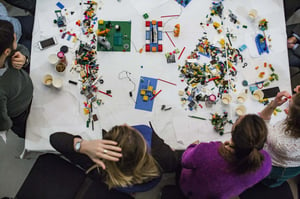Weathering the entrepreneurial storm is considered by many an art form in itself but an undeniable, universal truth is the unilateral impact of an extraordinary leader on the chances of succeeding in the face of great hardship. Yet the focus all too often concerns the understanding of the weather patterns, the choice of captain and the direction of the ship rather than how to turn the wheel, raise the mast or set the sails.
This is part 4 of my short series where I exhibit practical methods, actions and activities that entrepreneurial leaders can utilize to better sail through uncharted water. Today, we look into the importance of leaders to take a dynamic approach to processes, activities and methods in the firm.
From conducting numerous interviews and pure observation, it is clear that establishing flexible routines and methods that undergo constant scrutiny in order to able to adapt to contingencies is a crucial element in an ever-growing turbulent environment. Being dynamic is arguably a necessity or direct response in order to adapt to the high-velocity environments of competition and rapid change that is associated with the entrepreneurial context.
This is further evident as having a flexible approach towards the vision and long-term goals of the company is an important aspect in order to stay competitive and open to new opportunities, which is a key element of entrepreneurship. By not setting things in stone, the entrepreneurial leader can freely allocate resources and experiment to find better ways of doing things, whether it is a new activity or business model that fits better than the old, or simply as a way to tackle unexpected growth.
Call it lean, agile or whatever hot new term fits the narrative – we are threading on extremely theoretical ideas and concepts. Here are some practical examples instead:
Avoid a static vision
Just like anything else, the vision you have for your company does not have to remain a constant throughout changes and/or pivots during its lifetime. When asked to be more specific, a founder (120M SEK+ revenue) asserted that: “We have to be dynamic and flexible. That’s why I don’t like to reiterate a static vision, as we need to be able to adapt to the market and consumer”.
Pass employees the torch
By simply asking his employees “how would you go on to solve this?” another founder infers, continuing: “Nine times out of ten, they will know how to do it themselves”. By encouraging employees to figure out solutions to hard problems, you are effectively building an organization where the employees exhibit a high amount of autonomy in relation to goal setting and decision making. In turn, your company will become more dynamic and adaptable over time.
A/B test ways of working
Nowadays perhaps most akin to digital marketing, A/B testing (sometimes referred to as bucket testing or split testing) can be used to optimize methods, routines and activities within the firm as well. I had a lengthy conversation with a founder in Gothenburg, who on the topic of ‘routine innovation’ suggested that “We A/B-test a lot. We measure what works and what doesn’t, and everybody takes part of the result”.
If you have any questions, want more examples or would like to reach out about leadership and management in your organization, don’t hesitate to contact me at simon.hagert@centigo.se or at +46 76 887 54 36.




